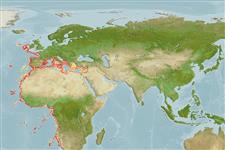Environment: milieu / climate zone / depth range / distribution range
Ökologie
seewasser bathydemersal; standorttreu; tiefenbereich 395 - 1700 m (Ref. 3587). Deep-water; 55°N - 27°S, 26°W - 36°E
Eastern Atlantic: Irish slope to Cape Verde, including the Mediterranean. Occurrence in southern Africa is based only on specimens from off Namibia and not 'west coast of South Africa' as reported by Iwamoto 1986 (Ref. 2800 in FishBase) (Ref. 11953).
Size / Gewicht / Alter
Maturity: Lm ? range ? - ? cm
Max length : 60.0 cm TL Männchen/unbestimmt; (Ref. 11953); max. veröff. Alter: 11 Jahre (Ref. 58045)
Snout long, narrow, sharply pointed. Dorsal scute row striating from just behind the head and extending to about behind a vertical through the anus, with more than 20 scute. Ventral scute row not reaching anus. Scute keels generally smooth blade-like, without multicuspid tips in small individuals (<30 cm), becoming more multicuspid with size. Scales adherent; belly completely scaled.
Primarily a pelagic feeder, feeds primarily on pelagic copepods, but also takes mysids, shrimps, cephalopods, fish, polychaetes and gastropods (Ref. 1371). Mainly reduced to fishmeal and oil (Ref. 1371).
Life cycle and mating behavior
Geschlechtsreife | Fortpflanzung | Ablaichen | Eier | Fecundity | Larven
Cohen, D.M., T. Inada, T. Iwamoto and N. Scialabba, 1990. FAO species catalogue. Vol. 10. Gadiform fishes of the world (Order Gadiformes). An annotated and illustrated catalogue of cods, hakes, grenadiers and other gadiform fishes known to date. FAO Fish. Synop. 125(10). Rome: FAO. 442 p. (Ref. 1371)
IUCN Rote Liste Status (Ref. 130435)
Bedrohung für Menschen
Harmless
Nutzung durch Menschen
Fischereien: weniger kommerziell
Mehr Information
ReferenzenAquakulturAquakultur ProfilZuchtlinienGenetikElectrophoresesVererbbarkeitKrankheitenVerarbeitungNutrientsMass conversion
Tools
Zusatzinformationen
Download XML
Internet Quellen
Estimates based on models
Preferred temperature (Ref.
123201): 4.7 - 13.7, mean 10.4 °C (based on 141 cells).
Phylogenetic diversity index (Ref.
82804): PD
50 = 0.5156 [Uniqueness, from 0.5 = low to 2.0 = high].
Bayesian length-weight: a=0.00309 (0.00121 - 0.00790), b=3.12 (2.90 - 3.34), in cm total length, based on LWR estimates for this (Sub)family-body shape (Ref.
93245).
Trophic level (Ref.
69278): 3.6 ±0.3 se; based on diet studies.
Widerstandsfähigkeit (Ref.
120179): mittel, Verdopplung der Population dauert 1,4 - 4,4 Jahre. (K=0.22-0.35).
Fishing Vulnerability (Ref.
59153): Moderate to high vulnerability (55 of 100).
Climate Vulnerability (Ref.
125649): Low vulnerability (13 of 100).
Nutrients (Ref.
124155): Calcium = 23.5 [12.6, 51.5] mg/100g; Iron = 0.403 [0.201, 0.813] mg/100g; Protein = 16.7 [15.0, 18.4] %; Omega3 = 0.241 [0.109, 0.505] g/100g; Selenium = 26.3 [10.7, 61.6] μg/100g; VitaminA = 8.08 [1.67, 36.00] μg/100g; Zinc = 0.38 [0.25, 0.59] mg/100g (wet weight);
